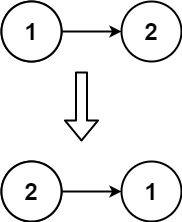Reverse Linked List
EasyGiven the head of a singly linked list, reverse the list, and return the reversed list.
Example 1:

Input: head = [1,2,3,4,5] Output: [5,4,3,2,1]
Example 2:

Input: head = [1,2] Output: [2,1]
Example 3:
Input: head = [] Output: []
Constraints:
- The number of nodes in the list is the range
[0, 5000]. -5000 <= Node.val <= 5000
Follow up: A linked list can be reversed either iteratively or recursively. Could you implement both?
Solution
Clarifying Questions
When you get asked this question in a real-life environment, it will often be ambiguous (especially at FAANG). Make sure to ask these questions in that case:
- Can the linked list be empty, or can the `head` ever be `null`?
- Are the values stored in the linked list nodes integers? If so, is there a range I should be aware of?
- Should the reversal be done in-place, modifying the original list, or should I create a new reversed list?
- Should I return `null` if the input `head` is `null`?
- Is a singly linked list guaranteed as the input?
Brute Force Solution
Approach
Imagine a train where each car is linked to the next. The brute force way to reverse this train involves physically rearranging all the cars. We'll meticulously copy the train's data to create a reversed version.
Here's how the algorithm would work step-by-step:
- First, walk through the entire train, making a note of the information in each car, one by one.
- Next, build a brand new, empty train.
- Now, starting from the last piece of information you noted down, create a new train car with that information and add it to the beginning of the new train.
- Continue this process, taking each piece of information in reverse order and adding new cars to the beginning of the new train.
- Once all the information has been transferred, the new train is the reversed version of the original.
Code Implementation
class ListNode:
def __init__(self, val=0, next=None):
self.val = val
self.next = next
def reverse_linked_list_brute_force(head):
node_values = []
current_node = head
while current_node:
node_values.append(current_node.val)
current_node = current_node.next
reversed_head = None
# Iterate backwards to create the reversed list
for value in reversed(node_values):
# Create a new node with the reversed value.
new_node = ListNode(value)
# Update head to create the new list.
new_node.next = reversed_head
reversed_head = new_node
return reversed_headBig(O) Analysis
Optimal Solution
Approach
To reverse a linked list, you essentially want to change the direction each element points. Instead of creating a new list, the optimal solution rearranges the existing one in place, one step at a time. This avoids extra storage and is faster.
Here's how the algorithm would work step-by-step:
- Imagine you have a train of linked cars where each car knows which car comes next.
- Start with the first car. Change its direction so it points to nothing, like a new last car.
- Now, pick up the next car in the original direction. Change its direction to point to the car that was previously first.
- Move the first car label to the car you just changed. It is now the beginning of the reversed sequence.
- Repeat the process for each car in the original list, always changing the direction and moving the 'first car' label.
- Once you reach the end, your original last car is now the first, and all the cars are pointing in the opposite direction.
Code Implementation
def reverse_linked_list(head):
previous_node = None
current_node = head
# We iterate until current_node becomes None
while(current_node is not None):
# Store the next node before reversing
next_node = current_node.next
# Reverse the current node's pointer
# This is the core reversal step
current_node.next = previous_node
# Move pointers one position ahead
previous_node = current_node
current_node = next_node
# previous_node is now the head of reversed list
return previous_nodeBig(O) Analysis
Edge Cases
| Case | How to Handle |
|---|---|
| Null or empty list | Return null immediately; there's nothing to reverse. |
| List with only one node | Return the original head as it's already reversed. |
| List with two nodes | Standard iterative or recursive reversal should handle this correctly by swapping the head and head.next, updating pointers. |
| Long linked list | The iterative approach scales linearly and won't cause stack overflow problems, as opposed to recursion. |
| List containing duplicate values | The values do not affect the reversal logic, so duplicates are irrelevant; reversal will still work as expected. |
| List containing negative values | Negative values within the linked list should have no impact on the pointer manipulation during reversal. |
| Memory limitations for extremely large lists | The iterative approach uses constant extra space, mitigating memory issues related to list size, unlike a naive recursive implementation which could cause stack overflow. |
| List with loop (corrupted data) | The standard reversal algorithm might lead to an infinite loop; a check for loop using Floyd's cycle detection algorithm could be incorporated before reversing or the reversal algorithm may need to be modified to handle this scenario |